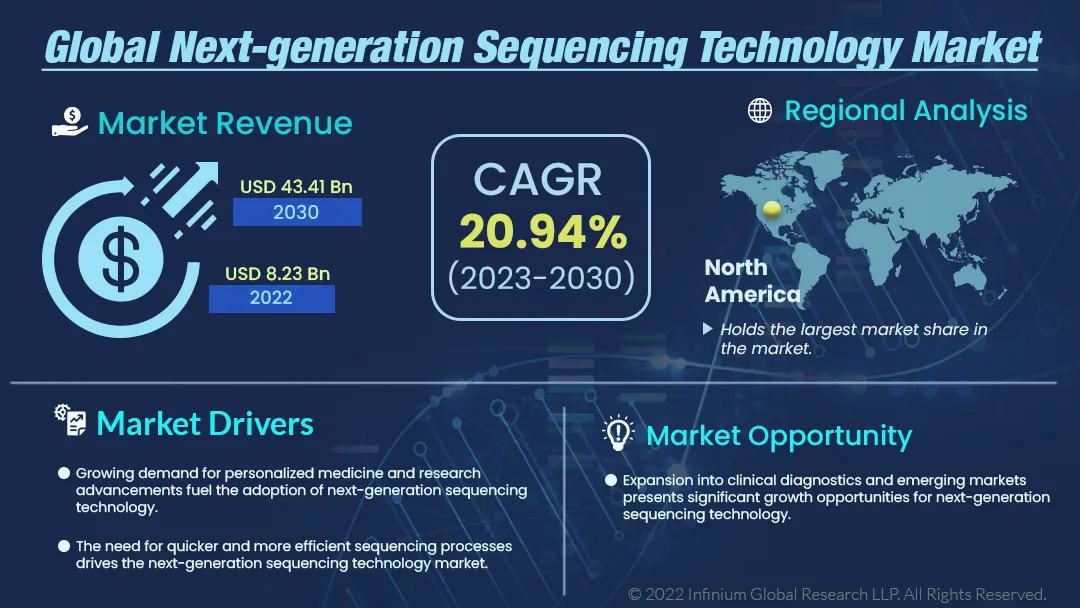Next-generation Sequencing Technology Market (Technology - Sequencing by Synthesis, Ion Semiconductor Sequencing, Sequencing by Ligation, Pyrosequencing, and Single-molecule real-time; Application - Clinical Application, and Research Application; End User - Academic and Research Centers, Pharmaceutical and Biotechnology Companies, and Hospitals and Clinics): Global Industry Analysis, Trends, Size, Share and Forecasts to 2030
A recent report published by Infinium Global Research on next-generation sequencing technology market provides in-depth analysis of segments and sub-segments in the global as well as regional next-generation sequencing technology market. The study also highlights the impact of drivers, restraints, and macro indicators on the global and regional next-generation sequencing technology market over the short term as well as long term. The report is a comprehensive presentation of trends, forecast and dollar values of global next-generation sequencing technology market.
Market Insight:
Next-generation Sequencing (NGS) technology represents a revolutionary advancement in the field of genomics, enabling the rapid and cost-effective sequencing of DNA and RNA. Unlike traditional Sanger sequencing, NGS techniques can process millions of DNA fragments simultaneously, making it a powerful tool for various applications in biology and medicine. The scope of NGS is vast and continues to expand such as in research, it has transformed genomics by facilitating large-scale genome sequencing projects, aiding in the discovery of genetic variations, and enabling the study of complex biological phenomena like gene expression and epigenetics. In clinical medicine, NGS plays a pivotal role in personalized medicine, enabling the identification of genetic markers for diseases, cancer profiling, and predicting drug responses. It has also found applications in agriculture, forensics, and microbiology, revolutionizing fields beyond human genetics. As NGS technologies become more accessible, their scope is likely to widen further, enabling researchers and healthcare professionals to unlock new insights into genetics and biology, ultimately leading to improved diagnostics, treatments, and a deeper understanding of the molecular basis of life.
The adoption of next-generation sequencing technology is being fueled by a growing demand for personalized medicine and ongoing research advancements. This innovative approach to DNA analysis allows healthcare professionals and researchers to tailor treatments and gain deeper insights into individual genetic profiles, leading to more effective therapies and breakthroughs in various fields. Additionally, the next-generation sequencing technology market is driven by the imperative for faster and more efficient sequencing procedures. However, the widespread implementation of next-generation sequencing is hindered by its high costs and the complexities associated with data analysis. These barriers can pose challenges for researchers and healthcare providers, limiting the technology's accessibility and adoption for routine genomic analysis and clinical applications. Although, the expansion of next-generation sequencing into clinical diagnostics and emerging markets offers substantial growth opportunities. As healthcare sectors in developing regions embrace NGS and its applications in patient care increase, the technology stands to gain broader adoption, driving its market potential and influence in global health.

North America holds the largest market share in the Next-generation Sequencing (NGS) technology market. The region's supremacy can be attributed to its well-established healthcare infrastructure, robust research and development activities, and a higher adoption rate of advanced medical technologies. Additionally, North America benefits from a strong presence of key NGS technology providers and a favorable regulatory environment that supports genomic research and clinical applications. Moreover, the Asia-Pacific region is considered the fastest-growing market for NGS technology. This growth is driven by factors such as a rising awareness of personalized medicine, increasing investments in genomics research, and the expanding biotechnology and pharmaceutical sectors in countries such as China and India. Moreover, efforts to improve healthcare access and affordability in the region have fueled NGS adoption for disease diagnostics and treatment optimization.
Report Scope of the Next-generation Sequencing Technology Market:
| Report Coverage | Details |
|---|---|
| Market Size in 2022 | USD 8.23 Billion |
| Market Size by 2030 | USD 43.41 Billion |
| Growth Rate from 2023 to 2030 | CAGR of 20.94% |
| Largest Market | North America |
| No. of Pages | 255 |
| Market Drivers |
|
| Market Segmentation | By Technology, By Application, and By End User |
| Regional Scope | North America, Europe, Asia Pacific, and RoW |
Segment Covered
The report on global next-generation sequencing technology market covers segments such as technology, application, and end user. On the basis of technology, the sub-markets include sequencing by synthesis, ion semiconductor sequencing, sequencing by ligation, pyrosequencing, and single-molecule real-time. On the basis of application, the sub-markets include clinical application, and research application. On the basis of end user, the sub-markets include academic and research centers, pharmaceutical and biotechnology companies, and hospitals and clinics.
Companies Profiled:
The report provides profiles of the companies in the market such as Agilent Technologies, Inc., Twist Bioscience, DNASTAR, Eurofins Scientific, F. Hoffmann-La Roche Ltd, Illumina, Inc., Macrogen, Inc., PacBio, QIAGEN, and Thermo Fisher Scientific Inc..
Report Highlights:
The report provides deep insights into demand forecasts, market trends, and micro and macro indicators. In addition, this report provides insights into the factors that are driving and restraining the growth in this market. Moreover, The IGR-Growth Matrix analysis given in the report brings an insight into the investment areas that existing or new market players can consider. The report provides insights into the market using analytical tools such as Porter's five forces analysis and DRO analysis of the next-generation sequencing technology market. Moreover, the study highlights current market trends and provides forecasts from 2023-2030. We also have highlighted future trends in the market that will affect the demand during the forecast period. Moreover, the competitive analysis given in each regional market brings an insight into the market share of the leading players.
Please Choose One of them.